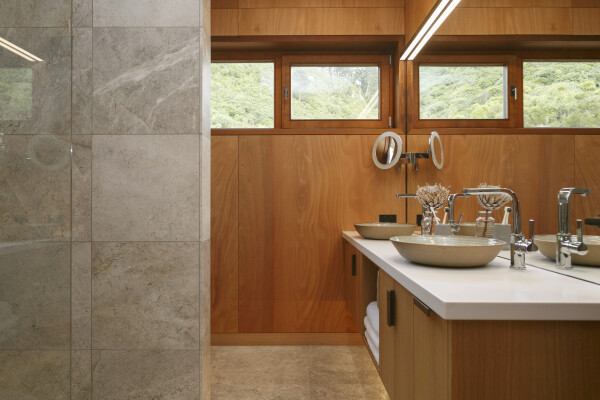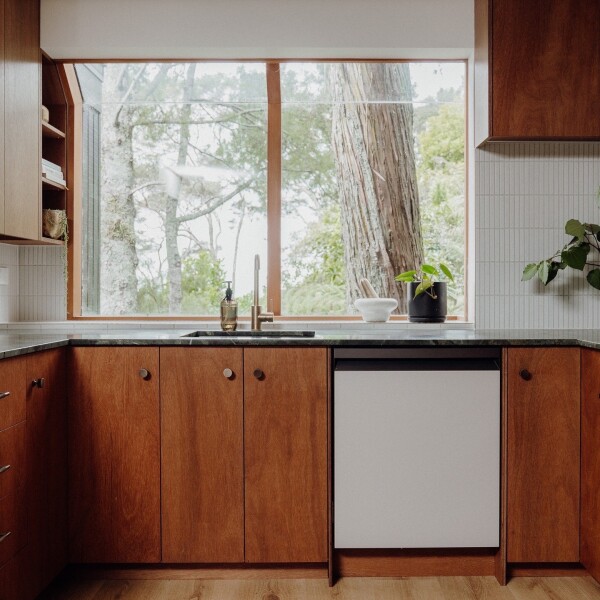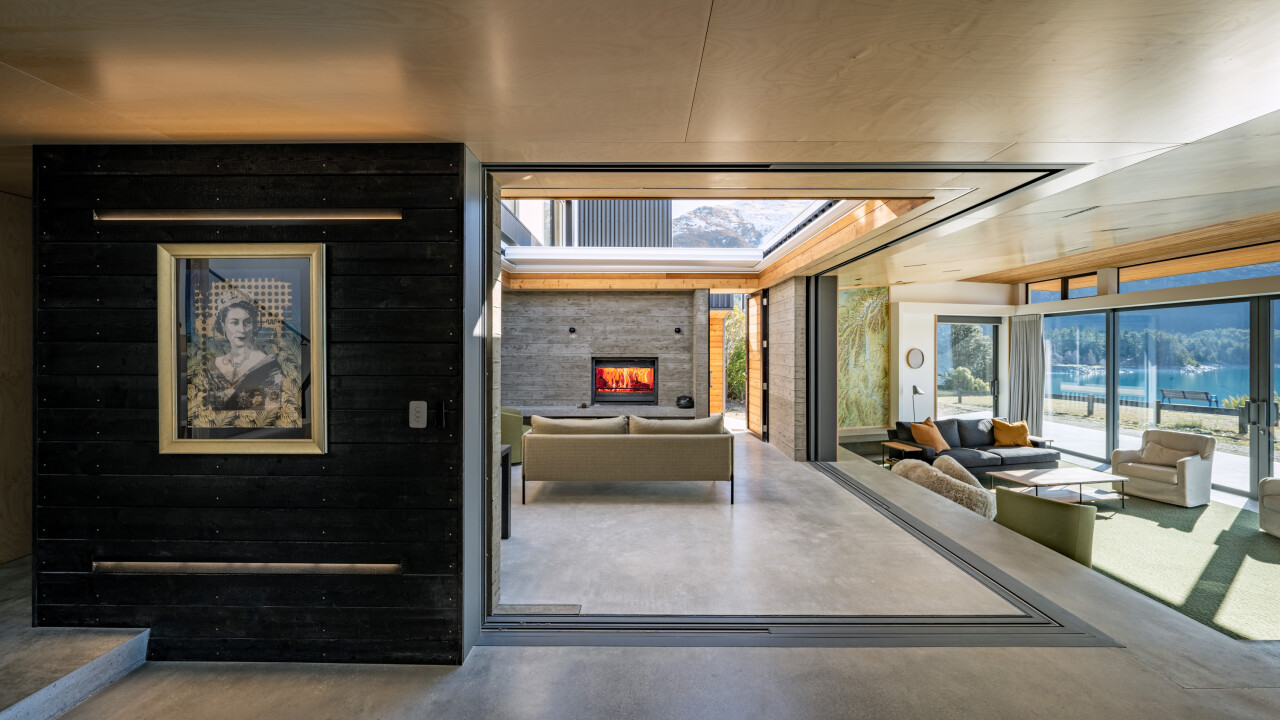You’ll often see marine plywood specified anywhere moisture is at play, such as soffits, outdoor living spaces and high-humidity interiors or areas where it suits the aesthetics such as a bar fit out. It’s a fairly familiar industry term, though not always a well-understood one. ‘Marine-grade’ might allude to it being waterproof, but the reality isn’t quite that clear-cut.
This guide walks through what marine-grade actually means, the options within that category, and how to get the best from the product you choose. It’s written for architects, builders, or anyone who needs to pick the right ply for the job and wants answers to all their questions at a glance.
Q1. What makes plywood “marine-grade”?
Marine ply is made up of hardwood veneers bonded with a waterproof adhesive to make it resistant to delamination and moisture.
Where standard ply might start to swell or shift at the joins, marine ply holds its shape, which is what makes it well-suited to boatbuilding, fine joinery, and the kinds of interiors or semi-exterior spaces where humidity is a constant factor.
That said, marine doesn’t mean waterproof. It’s still timber at its core. The sheet will cope well in damp or humid conditions, but if it’s sitting out in the rain or near constant moisture, it needs proper protection. We’ll come back to that in Q5.5.
Q2. Are there different types of Marine Plywood?
Yes there are, and the right one depends on what you’re using it for. The main differences come down to the timber species, how the sheet’s made, and whether it carries the BS1088 certification.
|
Regular Marine Grade Plywood - BB grade - Minimal gaps in the core - Can be a specific or mixed tropical hardwood species - WBP glue |
BS1088 Marine Grade Plywood - AB grade - Minimal/No gaps in the core - 100% tropical hardwood (same species) - WBP glue - Must be stamped with BS1088 |
BS1088-certified sheets come with a step up in price, but what you get for that difference is pure reliability, with panels that hold their shape, machine cleanly, and stand up to more extreme conditions.

Q3. What does “BS1088” mean?
BS1088 is the benchmark most people are talking about when they talk about “true” marine ply. It’s a British Standard that sets out how the sheet needs to be made, which veneers can be used, what glue holds them together, even the tolerances allowed in the core.
It’s not something the New Zealand Building Code requires, but plenty of architects specify it all the same. The stamp doesn’t make a sheet waterproof though, it just shows it’s been made under a proven, tightly controlled process. For many specifiers, that’s enough reassurance, and one less variable to worry about once the job’s underway.
Q4. How is Marine Ply different from H3.2 Structural Ply?
Marine and structural ply often get mixed up, because they’re both strong products that can be used externally. But they each have their own properties and aren’t made to be used interchangeably.
Like we covered earlier, marine ply is made of hardwood veneers bonded together with marine glue. The result is a strong, dense sheet with a smooth face that wouldn’t look out of place in a high-end kitchen. It’s the one to reach for when appearance matters as much as performance, which is why it’s popular for interior joinery, bathrooms, or covered exterior spaces.
Meanwhile, H3.2 structural ply is a different story. It’s made for strength and endurance rather than finish. Made from treated softwood, usually pine, it’s designed to bear the full brunt of exposure to the elements. You’ll see it anywhere that ply has to earn its keep, like construction sites, transport builds, exterior bracing, etc.
We often see marine ply specified where H3.2 would do the job better. The confusion usually comes down to the word ‘marine’, which makes people assume a level of waterproofing that it simply doesn’t have. Marine ply will still take on moisture if it’s left unsealed, especially in New Zealand’s harsh UV and those wet–dry cycles we all know too well.
Q5. When should I specify Marine Ply?
Marine ply comes into its own in covered or semi-exterior spaces where you want the look of hardwood with some extra protection against moisture. While popular in outdoor spaces, it’s equally at home in high-humidity interiors like bathrooms and laundries, provided it’s well-sealed.
It’s not, however, the right choice for full exterior exposure. Even the best marine ply will deteriorate if it’s left uncoated in the weather. For anything that faces the elements day in, day out, an H3.2 structural sheet will perform better and last longer.
Quick Reference Table
| Application | Recommended Ply | Notes |
| Interior wet area (bathroom cabinetry) | Visual-grade or marine ply + proper coating | Pre-finished options available |
| Covered exterior (e.g. soffit, patio kitchen) | BS1088 Marine Ply | Seal all sides |
| Fully exterior / exposed | H3.2 CCA Construction Ply | Treated softwood |
One thing to note: warranties for plywood installed in exterior conditions don’t usually sit with the supplier. They rest with whoever applies the coating or finish, since that layer is what ultimately protects the sheet. So choose your installer wisely.

Q6. Does Marine Ply need to be sealed?
Yes, every time. Even though marine ply handles moisture better than standard sheets, it still needs a proper coating system to keep it that way. The best time to seal is before installation, or straight after, if it’s too late and already fixed in place. Ideally, for full performance, a coating that fully encapsulates the panel is required. Because once moisture gets in, it’s almost impossible to draw it out again.
A good seal keeps the sheet looking sharp, stopping stains, warping, or that slow yellowing you sometimes see with radiata. For most jobs, a clear system like Resene Aqua Clear or a Dulux polyurethane does the trick. Natural finishes such as Osmo oils and waxes work well too for interior situations, especially if you’re after a softer, more natural look.
And don’t forget the edges or the back. Those are usually the first spots where moisture finds its way in, so they need the same attention to detail as the front.
Q7. Can Marine Ply be specified for New Zealand projects?
Yes, BS1088-certified marine ply is widely used in New Zealand for interior and covered exterior applications. The BS1088 standard shows that the sheet meets strict quality and durability benchmarks, but it’s a British manufacturing standard, not a NZ compliance code.
When marine ply is used here, it still needs to sit within a system that meets the NZ Building Code for structure, bracing, and fire performance. In most cases, those requirements are covered by the coating or wall system rather than the ply itself.
We can provide technical documentation or guidance if you’re specifying marine ply, get in touch.
Q8. How much does Marine Ply cost?
The cost of your order will depend on the grade, thickness, wood variety and whether you’re choosing from a standard or BS1088 range. As you’d expect, the pine-base construction options are most cost-effective, followed by hardwood marine ply, with BS1088 usually demanding the highest premium, around 10% more than standard marine ply on average.
Neither option is a budget choice. After all, you’re not just paying for a building material, you’re picking a hardwood product that is beautiful, natural and brings its own warmth to a space. Style and structure, combined in every sheet.

Inspo: Marine Ply Kitchen
In this kitchen by Variant Spaces, the cabinetry was created from Keruing BS1088 Marine Ply throughout. With a dense hardwood core and fine, even grain, it’s a timeless choice visually, and strong enough to last for generations.
The tone of the timber shifts gently through the space as it catches the light, creating a warm, natural feel in the heart of the home. It’s a great example of marine ply being used for its performance, with an appreciation for how well that performance translates into design.
The result is practical, attractive, and built to last, everything marine-grade plywood is meant to be.
Learn more
For details on our full range of marine-grade panels and certifications, visit our Marine Plywood page.
If you’d like advice on products, get in touch with our team. We’re always happy to talk through options, send samples, or help with an order.



